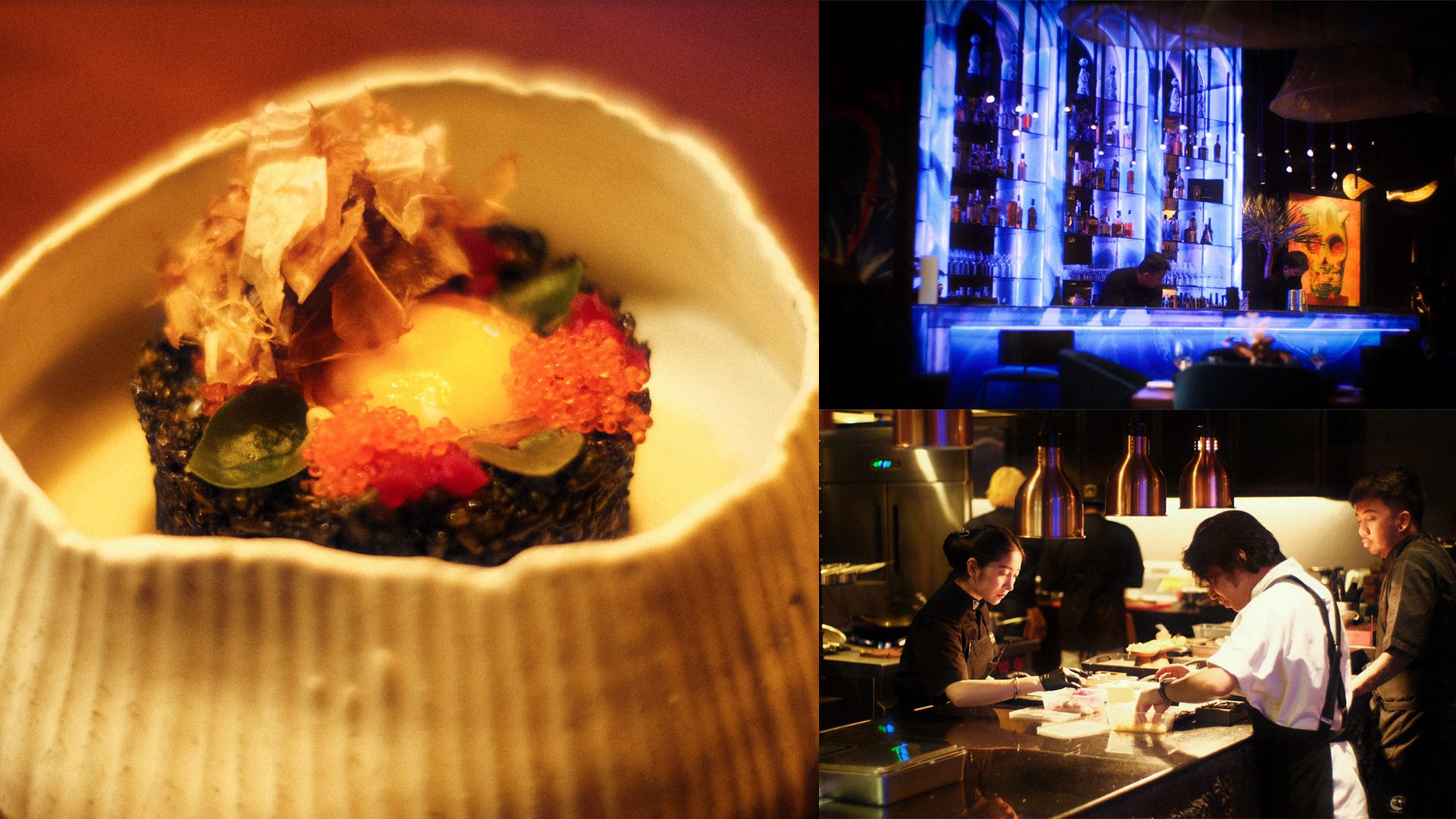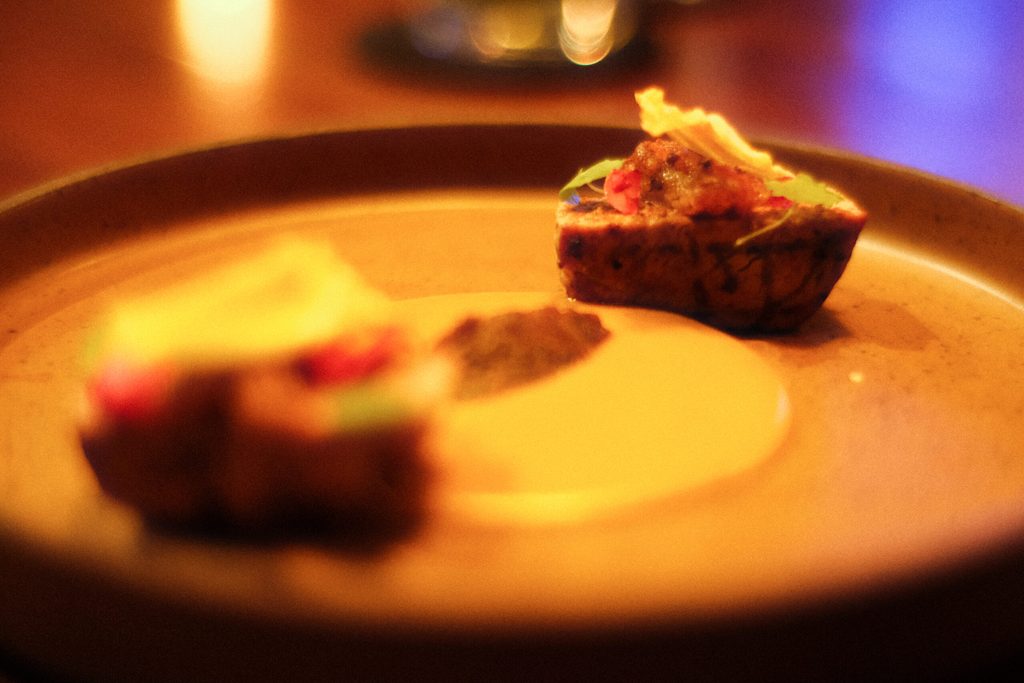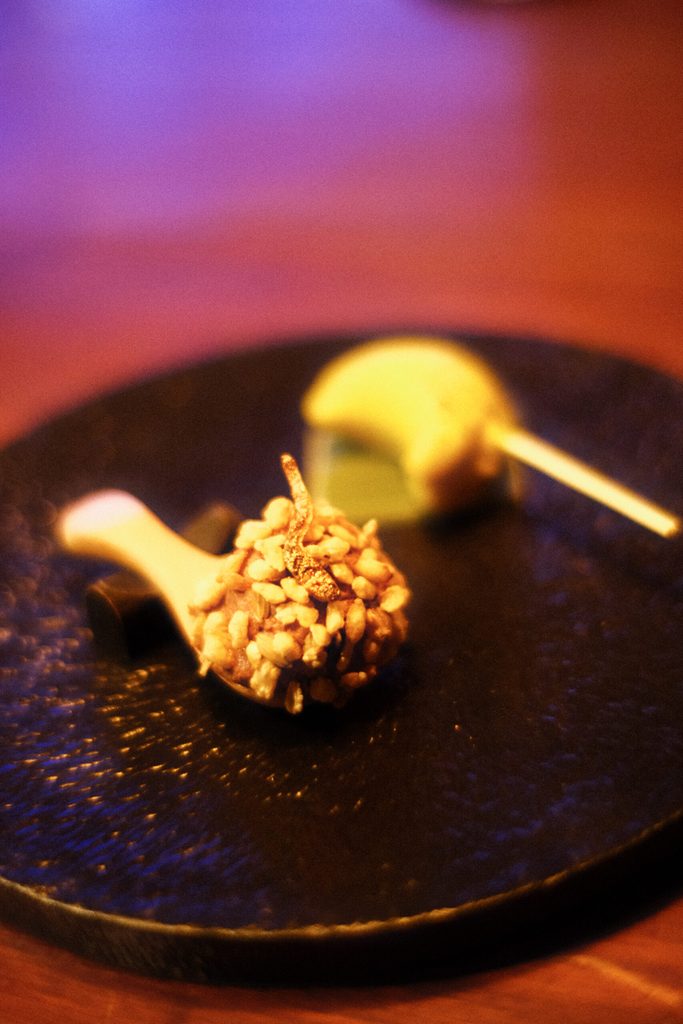SUMMARY
This is AI generated summarization, which may have errors. For context, always refer to the full article.

MANILA, Philippines – Alegria MNL is not your typical fancy schmancy fine dining restaurant. The intimate and hip Bonifacio Global City space screamed neonoir, edgy, and artsy as soon as I entered – the mood was gritty, the lighting dim yet accented by neon signages, and the curated decor and handpicked artwork were eclectic, unique, and reflective of Alegria MNL owner Chef Charles Montañez’s passion for progression and creative exploration.

The modern and sophisticated restaurant opened in late 2022, helmed by young but seasoned head chef Charles out of his frustration “from being limited with what [he] could contribute working for other people.” According to Charles, he always knew he had to execute his “brainchild” under his full control. He wanted to pursue his “passion for progression” and see where it would take him without feeling confined.

Charles pulled out all the stops for his first fine dining solo venture. Alegria MNL – the latest and highest-end addition to the Alegria Cantina, Cafe Alegria, and Buena Vida family – houses everything Charles wanted in his own space – neonoir-inspired, dark, and peppered with pops of color and his favorite art.

Alegria’s concept is very personal to Charles – everything served is the food he personally likes to cook and eat. “It’s basically me, opening myself to people and sharing my palate and philosophy towards cooking,” he told Rappler.

After cooking for different places in Metro Manila, Charles only found his specific passion for South American cuisine after working as head chef for a couple of Latin American restaurants in Singapore. There, they would cook on wood fire. “It made me pursue Latin and Filipino because I found so much soul in Latin cuisine compared to when I was doing the typical French and Spanish cuisines,” Charles said.

“Latin American cuisine’s approach is very complex, the flavors are festive, and it only makes sense to bridge the gaps for both cultures as we share a very identical flavor profile with them. We were both colonized by the Spaniards and then just made it our own,” he added. As a Filipino chef, Alegria’s concept just made perfect sense to him. After sourcing carefully chosen ingredients from South America and local farmers across the Philippines, Alegria’s Transcultural – a transcendence of two cultures with a lot of heart and soul – was born.
A culinary friendship that just works

Alegria MNL’s tasting menu is a multi-cultural, multi-textural, and multi-faceted culinary journey that takes you to different regions of both cuisines without one overpowering the other. The dishes were nothing too gastronomical or intimidating; native ingredients were highlighted, familiar flavors were present, but nothing was ever boring or predictable, thanks to the ingenious addition of atypical spices, chilis, condiments, and distinct cooking methods and tools used in the Latin Americas and in various Philippine regions.

It was eye-opening to discover different regional ingredients and specialties, experience how certain facets of our cuisine had its own counterparts in Mexican cuisine, and learn how merging different flavor profiles could be unified creatively.
Alegria offers a full course of 16 dishes (P5,400 per head), a 7-course tasting menu of 10 dishes (P3,595 per head), and a 6-course vegetarian menu (P2,800) of 8 dishes, exclusive of wine and cocktail pairings. We tried the 7-course set.
The Pao De Quiejo came in first, a small black bun looking adorable on a mushroom-looking vessel. Alegria MNL puts a lot of thought into each dish’s creative presentation – this was actually made out of the fungus called huitlacoche, which grows on old corn and is considered a luxury ingredient in Mexico.

It’s Brazilian cheese bread, made soft, really chewy (almost like mochi), and with a light, airy center. It’s more on the savory-tart side. Don’t be fooled by its cuteness – these little bread balls brought an umami oomph, due to the shaved truffle and cheese on top, and the earthy nuttiness of huitlacoche.
The Dinuguan was a favorite of mine; it felt almost like a palate opener and cleanser due to its pleasant acidity. The pork blood cup was filled with sinuglaw, a variety of kinilaw that’s a mix of raw and grilled seafood. Inside there’s smoked pork and tanigue that’s freshly caught in the morning, cured in a vinaigrette of souring agents that mimic the tanginess of a well-balanced dinuguan.

There’s also aji amarillo, a Peruvian yellow chili sourced from Peru, and a topping of potato and ikura (Japanese salmon fish roe) to provide some subtlety and balance to the powerhouse of flavors.
Now, onto the Okoy Tostoda, which is where “transcultural really starts,” Charles said, due to the “marriage between Filipino and Mexican going on.” It’s a harmonious play on the Mexican crispy taco – the tostada – and the equally crispy okoy made out of kalkag, which are baby prawns from Iloilo.

The crisp, delicate cracker is infused with flax and pumpkin seeds for an earthier taste to the crunch, and is topped off with blue crab, smoked tahong cream, and a simple but refreshing salad of grated squash and carrots cooked over hot coals, dressed in Iloilo’s spiced vinegar sinamak vinaigrette. The balance of salty and sour was specifically crafted so we didn’t have to dip the okoy in vinegar like we usually do.
The Pyanggang Coxinha is the Brazilian, tear drop-shaped version of the humble chicken croquette. “It may be the most simple looking, but this packs explosive flavor inside,” Charles said. Inside the crunchy croquette is Pyanggang Chicken, a native blacked coconut grilled chicken stew from the Tausug of Mindanao.

Immediately I tasted hearty chicken, garlic, ginger, and smoked gata in one bite, wrapped in a dough that is steeped in the aromatics of the stew. The croquette is coated in the crumbs of the smoked coconut.
My favorite of the night would be Alegria’s take on Elote, the famous grilled Mexican street corn snack. My curiosity was piqued instantly: What is that abnormally long baby corn coated in crispy quinoa puffs?

Charles sources this special kind of baby corn – or rather, teenage corn – from a farm in Ambiong, La Trinidad, Benguet, which specially grows this variety for Alegria only. “It’s bigger than your usual baby corn in groceries. We want it at this specific stage, because there is a specific texture and sweetness that is perfect for open fire,” Charles said. Truly, it wasn’t like any baby corn (or vegetable dish) I’ve ever tasted.
Alegria uses the Latin American “parilla” method often, which refers to the traditional open-fire hearth and grill where meat is cooked. Doing this to the baby corn plus adding chipotle results in a crisp yet moist vegetable that exudes a deep, smoky, and chargrilled flavor that is complemented by the addictive tanginess from the delicate Benguet strawberry glaze lightly slathered on the corn.
The ultimate Fil-Mex crossover is the Ilocos Empanada Birria, served with birria broth where the protein is cooked. The rich consomme is simmered for six hours, with beef and pork trimmings from the whole menu, plus Mexican chilies like pasilla, ancho chile, guahilo, and morita, boiled with avocado leaf, the counterpart of dahon ng laurel (bay leaf) in Mexico.

The house-made orange empanada is stuffed with homemade Ilocos longganisa, crunchy green papaya, and melted cheese. Instead of the egg inside, Alegria serves a salted egg mousse that is spread on top of the empanada before dipping it into the broth – which was honestly one of the best broths I’ve ever tasted. Aggressively rich in spices, peppers, smokiness, and “meatiness,” I sopped up that dip with every bite, and even took a few solo spoonfuls once the empanada experience was (unfortunately) over.
The sweet commercial break was the Nicuatole, a Mexican corn pudding similar to our maja blanca. For this, corn is cooked in an aggressive open fire before turning into a pudding.

It’s like an inihaw na maja blanca – smokiness is a key flavor profile in Alegria’s tasting menu. On top of the silky and soft pudding is corn foam, popcorn, corn caviar, and kesong puti. It was a creamy-sweet corn treat with a slight salty crunch from the popcorn.
For the main course, there was the Squid Silog, an ode to the quintessential Filipino breakfast, using Kalinga black rice cooked in squid ink. The smell instantly wafted in the air as soon as the gorgeous rice bowl was set in front of me.

The rice (which was a generous serving) was moist rich, and packed with umami squid ink flavor, served with stuffed squid on the side (which I wish there was more of), atchara, egg yolk, and bonito flakes. It was a loooot of rice, so I found myself already getting full a bit earlier than expected.
I loved the Dinarang na Kare Kare – it was a beautiful plate of hefty cuts of fork-tender, melt-in-your-mouth kurobuta pork, which is hailed as the “wagyu” of pork.

It worked well with the smooth and thick flor de calabaza (squash flower) and almond puree (it was like a refined, nutty kare-kare sauce), the salsa XO as the salty bagoong, and bits of smoked tripe for crunch. It’s not your traditional kare-kare, that’s for sure, but even if high-end ingredients were used, the dish was just as comforting and flavorful as I remember our Filipino peanut stew to be, just taken up a notch.
Dessert time! On a tiny plate, there was the Champorado Brigaderio – palitaw, chocolate foam, pinipig, and gold “fish” flakes. The Ferrero Rocher-looking ball of chocolate surprised me two ways – with an intense crunch from the pinipig, followed by a sweet, airy cloud of rich chocolate foam that quickly dissipated in my mouth.

The Banana QT – the adorable banana-shaped treat on a stick – stacks layers of banana mousse, banana cake, and banana chips for a multi-textural dessert that is sweet, subtle, and doesn’t necessarily have to scream BANANA for it to be a pleasantly fruity treat.
Last but not the least was my favorite dessert of the night, the Halo-Halo. It’s presented simply but beautifully – colorful halo-halo toppings in one bowl with an intricate barquillo biscuit on the side. It is then served theatrically with a live pouring of dry ice at our table.

Cool liquid nitrogen mist action aside, the dry ice’s job is to quickly freeze the sweet milk, which gives the now-milk ice cream a nice, slushy consistency. Mix it all up – halo-halo is the key – and enjoy the works: macapuno mousse, ube halaya, langka compote, pandan sago, nata de coco, leche flan, and red bean puree in one refreshingly milky bite, contrasted by the crushed crisp barquillo bits.
What lays ahead
At Alegria, both cuisines – whether seamlessly integrated together or on their own – felt respected and even hailed. Each ingredient and flavor profile had their own time to shine; the overall cohesive tasting menu didn’t feel disjointed. Not one dish tasted too similar to the other, which sometimes happens in other tasting menus. It is considered pricey for a tasting menu, but you are getting several dishes (I was full but not grossly stuffed at the end of our meal), and the playful experience itself is worth a first try.
“There is so much depth in this concept menu approach, and its been fun figuring out how to put them together in a plate,” Charles said.

“It gives us the same feeling of solving mathematical equations…but just not as stressful because I was never good at math,” he jokingly added.
With the rising success of Alegria, it’s exciting to see what else Chef Charles has up his (tattooed) sleeve. After all, he does plan to make Alegria “sustainable,” so he can work on auto-pilot, and for his brainchild to eventually be a “platform for growth for all the people who placed their faith in [him], the brand, and the company.”
“I find fulfillment when I see my cooks, chefs, and other team members moving up the brigade and finally creating concepts of their own. I’d be happy to utilize the creative side and hard work of the our people and turn it into a business, as a way for them to progress and find satisfaction in what they do,” Charles said.

“I believe there will be a lot in our future, given if we play our cards right. I have this dream of seeing my chefs open their own restaurants too, as I’d like to share the joy i’ve been getting here, being free to create and explore as part of growing,” he added.
Alegria’s Transcultural Menu will be served until April 14, which will be followed by a still-undisclosed new concept by Chef Charles. The restaurant is located at the ground floor of Uptown Parade, Uptown Bonifacio, 9th Avenue Corner 38th Street, Taguig City, and is open from Tuesdays to Sundays, starting 5 pm for dinner service. To make a reservation, you can message on Instagram. – Rappler.com
Add a comment
How does this make you feel?
There are no comments yet. Add your comment to start the conversation.